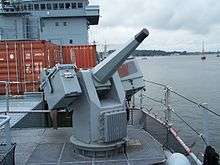Revolver cannon

A revolver cannon is a type of autocannon, commonly used as an aircraft gun. It uses a cylinder with multiple chambers, like those of a revolver handgun, to speed up the loading-firing-ejection cycle. Some examples are also power-driven, to further speed the loading process. Unlike a Gatling gun, a revolver cannon has only a single barrel, thus its spun weight is lower, lending itself to gas operation. Automatic revolver cannon have been produced by many different manufacturers.
History
Precursors

An early precursor was the Puckle gun of 1718, a large flintlock revolver gun, manually operated. The design idea was impractical, far ahead of what 18th century technology could achieve.
During the 19th century, Elisha Collier and later Samuel Colt used the revolver action to revolutionize handguns.
The Confederate States of America used a single 2-inch, 5-shot revolver cannon with manually rotated chambers during the Siege of Petersburg.[1] The gun was captured in Danville, VA by Union forces on April 27, 1865.[2]
(The Hotchkiss Revolving Cannon of the late 19th century was not a revolver cannon in the modern sense, being of a Gatling type.)
In 1905, C. M. Clarke patented[3] the first fully automatic, gas-operated rotary chamber gun, but his design was ignored at the time. Clarke's patent came as reciprocating-action automatic weapons like the Maxim gun and the Browning gun were peaking in popularity.[4]
Around 1935, Silin, Berezin and Morozenko worked on a 6000 rpm 7.62 mm aircraft machine gun using revolver design, called SIBEMAS (СИБЕМАС), but this was abandoned.[5]
Modern
It was not until the mid-1940s that the first practical revolver cannon emerged.[6]
The archetypal revolver cannon is the Mauser MK 213, from which almost all current weapons are derived. In the immediate post-war era, Mauser engineers spread out from Germany and developed similar weapons around the world. Both the British and French made outright copies of the 30 mm versions of the MK 213, as the ADEN and DEFA, respectively. Switzerland produced the Oerlikon KCA. While the American M39 cannon used the 20 mm version, re-chambered for a slightly longer 102 mm cartridge, intermediate between the 213's 82 mm and Hispano-Suiza HS.404's 110 mm. Several generations of the basic ADEN/DEFA weapons followed, remaining largely unchanged into the 1970s.
Around that time, a new generation of weapons developed, based on the proposed NATO 25 mm caliber standard and the Mauser 27 mm round. A leading example is the Mauser BK-27. In the 1980s, the French developed the GIAT 30, a newer generation power-driven revolver cannon. The Rheinmetall RMK30 modifies the GIAT system further, by venting the gas to the rear to eliminate recoil.
Larger experimental weapons have also been developed for anti-aircraft use, like the Anglo-Swiss twin barrel but single chamber 42 mm Oerlikon RK 421 given the code name "Red King" and the related single-barrel "Red Queen" - all of which were cancelled during development.[7] The largest to see service is the Rheinmetall Millennium 35 mm Naval Gun System.
Soviet revolver cannon are less common than Western ones, especially on aircraft. A mechanism for a Soviet revolver-based machine gun was patented in 1944.[8] The virtually unknown Rikhter R-23 was fitted only to some Tu-22 models, but later abandoned in favor of the two-barrel, linear action Gryazev-Shipunov GSh-23 in the Tu-22M. The Rikhter R-23 does have the distinction of being fired from the space station Salyut 3. The Soviet navy has also adopted a revolver design, the NN-30, typically in a dual mount in the AK-230 turret.
Characteristics
With a single barrel mated to a cylinder with multiple chambers, this type of autocannon uses the revolver principle to accelerate the cycle of loading, firing and ejecting multiple rounds of ammunition, achieving a very high rate of fire compared to conventional cannon of the same calibre.
Compared to Gatling guns
Automatic revolver cannon generally have a lower maximum sustained rate of fire than Gatling guns, as all the rounds are fired through a single barrel, which suffers from much higher heating loads. Some cannon caliber Gatling guns have a rate of fire of up to 10,000 rounds per minute (such as the Gryazev-Shipunov GSh-6-23), while revolver cannon typically have a rate of fire no more than 2,000 rounds per minute. On the other hand, revolver cannons are generally able to be made much lighter than gatling guns, requiring less support and mounting hardware. Gatling type guns spin the whole multiple barrel and breech assembly, which in equal caliber versions can weigh hundreds of kilograms more.
Types
- ADEN cannon
- DEFA cannon
- GIAT 30
- M39 cannon
- Mauser BK-27
- Mauser MK 213
- Oerlikon KCA
- Rheinmetall RMK30
- Rikhter R-23
See also
- MANTIS - The German Army's new very short range protection system
- ShVAK cannon
- ShKAS machine gun
- Skyshield
References
- ↑ George M. Chinn (1951). The Machine Gun, History, Evolution and Development of Manual, Automatic and Airborne Repeating Weapons, Vol. 1. U.S. Government Printing Office. p. 46.
- ↑ F. Lawrence McFall, Jr (2001). Danville in the Civil War. H.E. Howard, Inc. p. 107.
- ↑ http://www.google.com/patents/US794852
- ↑ Chinn, p. 182
- ↑ Болотин, Давид (1995). История советского стрелкового оружия и патронов (in Russian). Полигон. p. 235. ISBN 5-85503-072-5.
- ↑ Anthony G. Williams (2002). Rapid Fire: The Development of Automatic Cannon, Heavy Machine-Guns and Their Ammunition for Armies, Navies and Air Forces. Airlife. p. 50. ISBN 978-1-84037-435-3.
- ↑ Anthony Williams, "The Red Queen and the Vigilante"
- ↑ Пулемет с барабанным камерным питанием А.И. Коновалова. 1944 г.Авторское свидетельство 66799 МВС.
- George M. Chinn (1955). The Machine Gun: Design Analysis of Automatic Firing Mechanisms and Related Components, Volume IV, parts X and XI. Bureau of Ordnance, Department of the Navy, US Government Printing office. pp. 178–209.